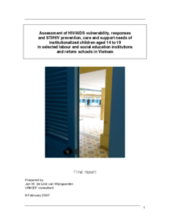Largely as a result of being cut off from the protection and care of their families, communities, and friends, children in institutions are increasingly vulnerable to HIV. In institutions, services to educate children on HIV/AIDS prevention, as well as appropriate treatments for children already infected, tend to be limited in scope and access. Many children are not even informed of their HIV status.
This assessment aims to map the vulnerability of children in three types of institutions, to identify critical needs, and to design practical, rapid, and easy-to-implement solutions that reduce child vulnerability. The results of the study will be used to design new strategies and policies to immediately reduce the vulnerability of institutionalized children in Vietnam for use by the Ministry of Labor, Invalids, and Social Affairs, as well as the Ministry of Public Security, in anticipation of longer-term solutions directed at decreasing the predominance of institutionalization as a strategy to deal with “social evils.”
Through use of questionnaires and group discussion, this paper seeks to investigate three major research questions:
-
What is the HIV risk and vulnerability of children and adolescents in selected Vietnamese institutions, and how does this compare to peers outside institutions?
-
What prevention and care programs are already in place to reduce HIV vulnerability for children and adolescents in institutions?
-
How, and by whom, can the risk and vulnerability of institutionalized children be reduced during institutional care and after these children leave?
The document ends with a series of conclusions and recommendations, including:
-
Increased government investment in HIV prevention education, care, and support
-
Development of minimum standards for institutional care
-
Appropriate staff training
-
Intensification and diversification of HIV prevention activities
-
Improvement of HIV counseling and testing practices
-
Increased access to antiretroviral therapy for institutionalized children
-
Drafting and implementation of an after-care reintegration plan for children leaving institutions
©UNICEF

